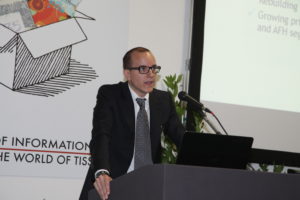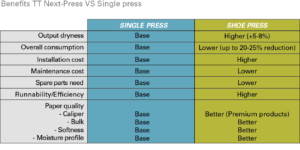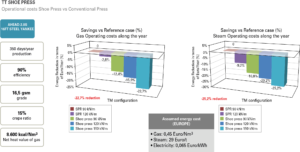The shoe press as a multi-purpose solution for a paper mill that produces tissue and can change its manufacturing parameters from time to time. This is the solution offered by the Italian tissue supplier Toscotec, which exports its technology to the whole world.
The shoe press has been a major innovation in tissue production, originating from the need felt by paper manufacturers to substantially increase the quality of the finished product and reduce gas and steam energy consumption to the least. Over time the machine evolved from a single press to a double press, up to the shoe press. The advantage of the press lies in the degree of dry that can come out of the press, which appears to be much higher with this latest press layout. Furthermore, if one considers that 1% more dry from a press corresponds to about 4% less in energy consumption, the total energy becomes 20-30% less in energy consumption in terms of drying. This is quite a significant value.
Configuration of the shoe press
«Le motivazioni per cui una cartiera dovrebbe passare a una shoe press sono diverse: maggiore efficienza della macchina, minori consumi e la possibilità di produrre carte premium».

During the Miac Tissue session in Lucca, Italy, Toscotec’s Sales & Application Engineer Matteo Giorgio Marrano, highlighted the advantages offered by TT NextPress, i.e. the shoe press developed by the Italian company Toscotec in 2013. «From a technical viewpoint, our solution provides for a larger pressing area compared to a standard press, whereby this larger pressing area changes due to a longer period in which the paper stays in contact with the nip. Hence the possibility to reach a higher bulk, i.e. a bigger specific volume of the paper sheet, which makes it possible to develop premium products, or to achieve more drying, i.e. more dry after the press, with values up to 46-47%, which in turn translates into lower energy consumption. Another interesting factor lies in the possibility to hypothetically to go from a single press configuration to a shoe press with very little investment, both in terms of time and financial resources. The TT NextPress can be installed on machinery up to 2thousand metres, thereby covering the entire production range on narrow and wide tissue machines and, depending on the level of dry one wishes to obtain, it can work with operational values equal to 90 KN/m up to a maximum of 150 KN/m, as well as up to a 46% of dry after the press».
Final tilt
One of the most important features of the Toscotec model is the presence of two lines of pistons, placed along the width of the skid, both in the longitudinal and in crosswise direction. The pistons make it possible to control different areas of the press where action is still possible at the level of the nip, thereby refining the quality of the finished products. «Each line can be controlled and steered independently on three areas, two of which at the borders, for a total of six different areas where interventions are possible. Thanks to the pistons it is therefore possible to manage of the performance of the same shoe press with the so-called tilt. The tilt is the ratio between the force produced by the two pistons at the exit of the press and the force at the entrance of the press; the higher the tilt value, the higher the pressure coming out of the press and, as a consequence, the bigger the dry that can be obtained». Mr. Giorgio Marrano explains that the tilt cannot be modified during the normal functioning of the machine depending on desired finished product. «The tilt value normally ranges between 1, which means bigger bulk, and 6, to indicate more dry after the press stage. This shows the flexibility of our shoe press, which enables to work with a constant load and a different tilt value, or, conversely, with a constant tilt value and a different load. All of the above makes it possible for the paper mill to manufacture a finished product depending on the needs in terms of the desired bulk and energy savings. Furthermore, the possibility to work independently on six areas makes it possible to better manage the humidity profile obtained on the resulting paper».
From theory to practice
Opting for a shoe press certainly implies a major investment for a paper mill, however the investment delivers evident advantages, «first and foremost more dry which in turn results into lower consumption. Installation costs are of course higher, this is however compensated by lower maintenance costs and, based on our experience, on machine better efficiency, i.e. less breakdowns and standstill and above all the possibility to produce premium papers, i.e. those niche products for which higher caliper and bulk values, more tenderness, volume and a better humidity profile are searched for».
Mr Giorgio Marrano highlights that all this data has been confirmed over time by field measurements. In particular, this data has been confirmed by two recent references of the company, two of which expressed in 2015 and a third one which is being installed during 2017.
The first two references refer to two companies active in Portugal. «The first reference stems from Fortissue, a company we delivered a 2thousand m/min narrow tissue machine in 2015 that produces 110 tons/day of paper. In this case we followed the project from the beginning to the end. We also took care of pulp preparation and provided a 16-foot yankee dryer and a rewinder» tells the engineer. In September of the same year, another reference came from The navigator company, again from Portugal: in this case we «installed a 2thousand m/min in their plant, where in 2009 a first Toscotec tissue paper mill had already been installed. Both the Fortissue press, and the press for The navigator company work 120 KN/m».
The installation currently being installed in 2017 is in South Africa. «This is a 2 thousand m/min installation, for which the shoe press will work at 150 KN/m for the first time». In this case, too, this is a turn-key project, for whith Toscotec will follow the entire project development.
«These are excellent results that we have been capable to achieve in very limited time», says Mr. Giorgio Marrano, «especially if one considers that our shoe press for the tissue sector was developed only in 2013. Choosing a similar solution», concludes the manager, «is ideal if one wants to achieve energy saving, better efficiency in terms of machine and machinability and above all if one wishes to produce premium papers».


